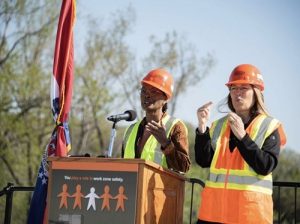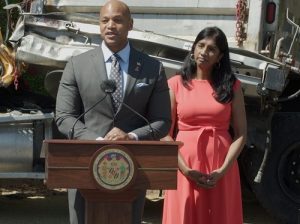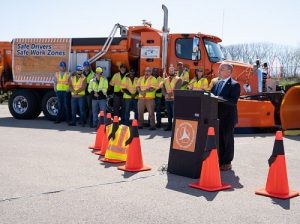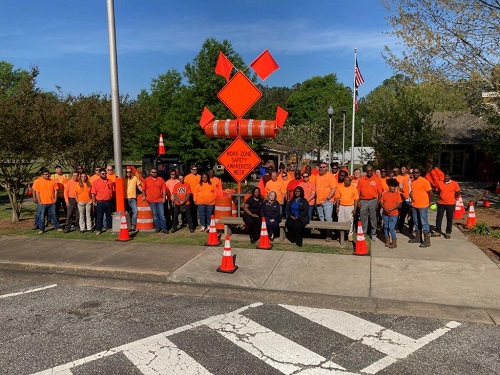The annual National Work Zone Awareness Week outreach campaign – conducted April 17-21– involved state departments of transportation and other industry groups from across the country in a variety of public events aimed at reducing fatalities and injuries caused highway work zone crashes.
[Above photo by Georgia DOT]
At a national kickoff event for the week-long campaign hosted by the Missouri Department of Transportation in the shade of the I-70 Westbound Missouri River Bridge project, Gloria Shepherd – executive director of the Federal Highway Administration – stressed that her agency “intends to use every program and funding option at our disposal to make where infrastructure repairs, maintenance, and construction are underway safer for workers and motorists alike.”

“The safety of highway workers and others on roads, bridges and highways across the country is FHWA’s number one priority,” she said in a statement.
“Work zone safety is personal for us,” added MoDOT Director Patrick McKenna at the event. “It is about getting home safely to your family, to your friends, after every single shift every single time during your [transportation] career. There are lives on the line every day, in every state, in any given work zone people are dying. The decisions you make in work zones could be the difference between life and death, for our workers, yourself, and everyone you share the road with.”
In 2021 – the most recent year for which data are available – 956 people died in highway work zone crashes in the United States, the District of Columbia, and Puerto Rico. The National Work Zone Safety Information Clearinghouse, operated by the American Road and Transportation Builders Association and the Texas A&M Transportation Institute in coordination with FHWA, also offers additional data points on work zone fatalities.

The Maryland Department of Transportation – like many states – hosted a state-level work zone safety kickoff event during the one-week campaign, featuring Governor Wes Moore (D), Lieutenant Governor Aruna Miller, and Maryland DOT Secretary Paul Wiedefeld.
“As we build an efficient and equitable transportation network … we must prioritize safety over speed” Gov. Moore said in a statement. “That is why I’m announcing the formation of a highway work zone safety work group to develop tangible solutions to protect workers, drivers and passengers.”
Lt. Gov. Miller – a transportation engineer with 20-plus years of experience – will lead the Maryland work zone safety task force.
“I’ve seen firsthand the safety challenges associated with highway work zones,” she said. “The safety of all highway users, as well as those who improve and maintain our highway network, is paramount.”

“Work zone safety is everyone’s responsibility,” Wiedefeld added. “The men and women of our highway work crews are providing a vital service – maintaining and improving the transportation system we rely on every day. We all must work together to provide them with the respect, and the protection, they deserve.”
Craig Thompson, secretary of the Wisconsin Department of Transportation and the current vice president of the American Association of State Highway and Transportation Officials – expressed similar sentiments during a kickoff event in his state.

“Work zones are temporary, but our decisions behind the wheel can make an impact forever,” Thompson noted in a statement. “The people working behind the barrels rely on us to drive safely. Glancing at a text or social media alert while driving is not worth it. Let’s work together to avoid distractions and stay focused on the road ahead. Safe drivers create safe work zones.”
“We are focused on improving the safety of our roads for motorists and our construction workers, but there is still work to do and we cannot do it alone,” noted Russell McMurry, commissioner of the Georgia Department of Transportation, in a statement.
“Help us save lives in and around construction work zones so our crews can make it home after their shifts,” he stressed. “The near miss this time may be a loss of life next time.”

Kris Strickler, director of the Oregon Department of Transportation, echoed that message about “near misses” as well.
“Our crews are experiencing more close calls than ever – and a close call is mere inches from becoming a crash,” he said in a statement. “We are very concerned about safety in work zones.”
Driving behavior around work zones is such a concern that Oregon DOT’s Work Zone Safety Task Force is capturing data on “near misses” to lessen the risk. A new online reporting system allows an Oregon DOT employee or contractor with a smart phone and a QR code to report a near-miss incident anonymously.

While the system is in development and reporting is voluntary – meaning under-reporting is likely, the agency pointed out – the pilot testing period from August to December 2022 recorded 133 near-miss reports, or an average of 27 incidents per month. Of those, two-thirds involved a vehicle nearly hitting equipment or crews, or a driver going around a flagger, all extremely risky behaviors for people in the vehicles and the work zones.
Several state DOTs issued videos detailing the dangers faced and tragedies suffered by state personnel and contractors working in highway work zones.
Workers for the Utah Department of Transportation detailed their highway construction zone safety concerns:
Farther west, Sam Dawson – a Washington State Department of Transportation maintenance worker – detailed his personal experience with a recent work zone collision:
Meanwhile, a Kentucky Transportation Cabinet video illustrated the terrible aftereffects of two separate work zone incidents suffered by one of its contractors – with one worker losing their life in a crash, with the other one dying as the result of gunshot wounds from a random work zone attack:
State DOT executives also delivered personal messages via video to help the motoring public better understand the need to slow down and be alert when traveling through highway works zones.
In the end, what many fail to recognize is most people killed in work zone crashes are motorists and their passengers, noted Jack Marchbanks, director of the Ohio Department of Transportation.

“Too many of these work zone crashes are the result of drivers not paying attention, speeding, or following the vehicle in front of them too closely,” he said in a statement.
“It is imperative that drivers give extra attention to the road in work zones and obey the speed limits and other signs so that everyone makes it home safe at the end of the day,” he added.
 Top Stories
Top Stories
Modal Administrators Speak at AASHTO Annual Meeting
December 5, 2025 Top Stories
Top Stories

